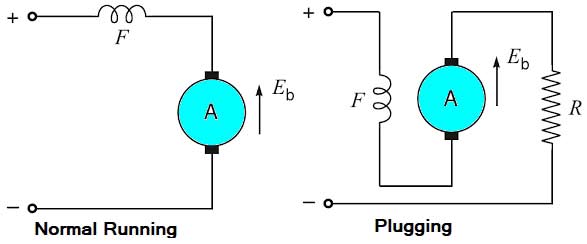During plugging, external resistance is also introduced into a circuit to limit the flowing ____
During plugging, external resistance is also introduced into a circuit to limit the flowing ____
Right Answer is:
None of these
SOLUTION
- Plugging is also called reverse current braking.
- The connections of the motor are reversed, reversing the direction of torque, thereby bringing it to a quick stop. For this, either the direction of the field current or the direction of the armature current is reversed.

- The field circuit usually has a large time constant due to the high value of inductance, so the time taken to bring the field current to zero is large. Hence, it is usual to reverse the armature current.
- If we suddenly reverse the terminals of the source, the net voltage acting on the armature circuit becomes (V + E,). The so-called counter-emf E of the armature is no longer counter to anything but actually, adds to the supply voltage V.
- This net voltage would produce an enormous reverse current, perhaps 50 times greater than the full-load armature current. This current would initiate an arc around the commutator, destroying segments, brushes, and supports, even before the line circuit breakers could open.
- Hence, an external series resistance is inserted in the armature circuit simultaneously with the reversal of the armature current. Braking torque can be regulated by varying the magnitude of this resistance.
The disadvantages of this method are:
1. The kinetic energy of the motor is dissipated in the external resistance in the form of heat. So, this method of braking is inefficient.
2. The braking in this method fails in case of failure of the supply.
